Xiaonanhai is located in Qianjiang District, Chongqing Municipality, and is a national 4A-level tourist attraction. It is an alpine freshwater barrier lake scenic area integrating mountains, waters, islands, gorges and other landscapes, covering an area of approximately 30 square kilometers, with a water area of 2.87 square kilometers. Inside the scenic area, the lake is over 5,000 meters long, with a maximum width of 2 kilometers, an average water depth of 30 meters, a maximum depth of 60 meters, and a maximum water storage capacity of 67 million cubic meters. It is rich in forest resources, with more than 140 species of arbor trees and over 50 species of fish, serving as a habitat for many rare species. The scenic area is home to the Qianjiang Folk Custom Museum, the first Tujia folk ecological museum in the Wuling Mountain Area, which consists of an exhibition center and 13 Tujia villages in Banjiaxi.
Historical Culture
Xiaonanhai is a canyon flat lake formed by the Bingchen Earthquake in the sixth year of the Xianfeng reign of the Qing Dynasty (1856), and is one of the best-preserved ancient earthquake sites in China. During the earthquake, rolling rocks formed a natural dam that is 1,170 meters long from north to south, 1,040 meters wide at the bottom, 67.5 meters high, and 70 meters wide at the overflow weir. This dam blocked the water of Banjiaxi, forming a natural lake. The surrounding area of Xiaonanhai is a gathering place for the Tujia and Miao ethnic groups, where most dwellings are stilted buildings, and the ethnic customs are rich and distinctive. It is also a cradle of early revolutionary activities, witnessing important revolutionary movements on the eve of the 1911 Revolution and during the Second Chinese Civil War.
Major Attractions
Xiaonanhai Lake
Xiaonanhai Lake is the core natural landscape of the scenic area. As a barrier lake formed by the 1856 earthquake, it has a water area of 2.87 square kilometers. The lake surface is irregularly oval-shaped, about 1.8 kilometers long from east to west and 1.5 kilometers wide from north to south. With an altitude of 670.5 meters above sea level, an average water depth of 30 meters, and a maximum depth of 52.7 meters (located in the northwest of the lake), the lake water is clear and transparent, with a visibility of 3-5 meters. Various freshwater fish such as carp, crucian carp, and silver fish thrive in the lake, making it one of the important freshwater fishery bases in southeastern Chongqing.
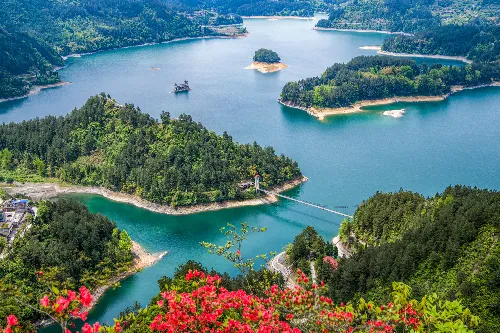
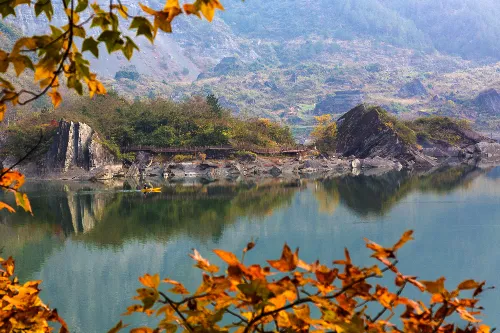
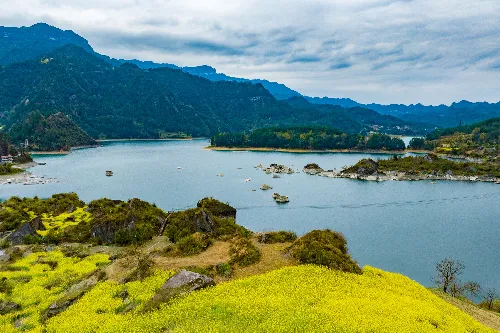
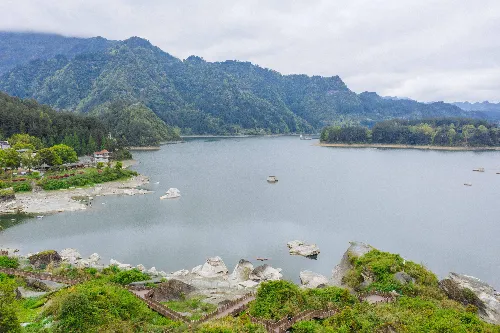
Chaoyang Temple Island
Located in the Xiaonanhai Geopark, it gets its name from the Chaoyang Temple on the island. Also known as "Butterfly Island" due to its butterfly-like shape, it covers an area of 6.46 hectares. Chaoyang Temple was rebuilt in 1764 (the 29th year of the Qianlong reign of the Qing Dynasty) by Yang Yuncai, a magistrate of Qianjiang County, who did good deeds. Originally, the temple had a quadrangle courtyard with 60 rooms, enshrining Guanyin of the South Sea, 24 heavenly gods, and 18 arhats. Unfortunately, Chaoyang Temple was destroyed in the earthquake.
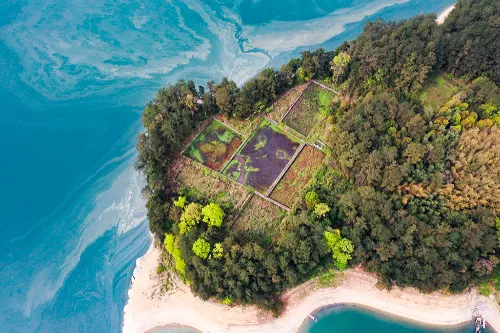
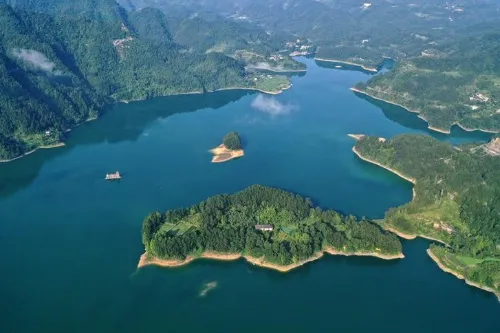
Niubei Island (Ox Back Island)
As the largest island in Xiaonanhai, it covers an area of approximately 8.33 hectares. Its right side resembles a lying ox head, while the middle part is like a broad ox back submerged in water. The "ox" looks back at Yueliangbao (Moon Fortress), a small island in the center of the lake, forming the scenic view of "An Ox Gazing at the Moon".

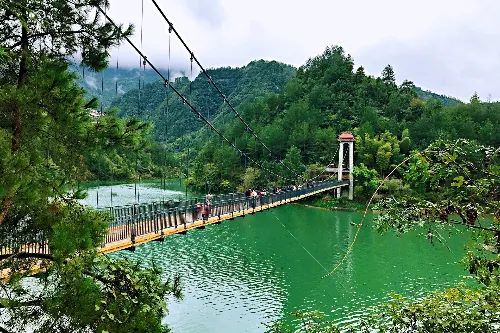
Laoguanping Island
As the smallest island in Xiaonanhai, it covers an area of 0.57 hectares. It gets its name because it is often inhabited by elderly cranes with long beaks and gray-white feathers. The island is like a small green spiral shell in the vast blue waves of the lake.
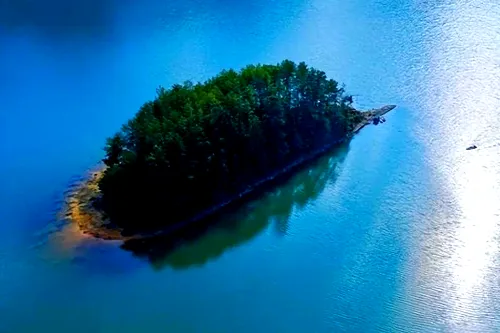
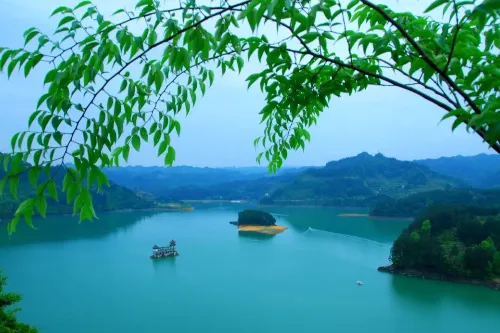
Da Kua Rock and Xiao Kua Rock
Da Kua Rock (Large Collapsed Rock) is composed of siltstone and shale from the Luoreping Formation of the Silurian System. It is in the shape of a regular triangle, with a width of about 200 meters at the bottom, a height of about 120 meters, and a cross-sectional area of approximately 5,000 square meters. It is the most typical and largest cliff in the park, with a magnificent and grand momentum. Xiao Kua Rock (Small Collapsed Rock), also made of siltstone and shale from the Luoreping Formation of the Silurian System, has an irregular shape, with a width of about 80 meters at the bottom, a height of about 60 meters, and a cross-sectional area of around 2,000 square meters.
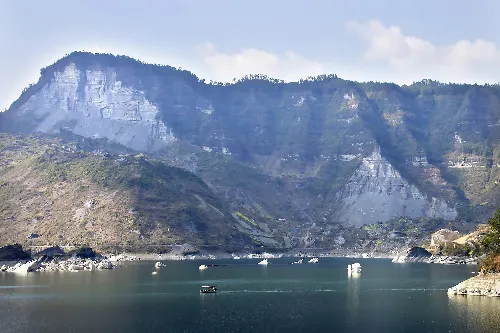
Qianjiang Folk Custom Museum
With an investment of 20 million yuan, a 3,000-square-meter exhibition center was built to display architectural culture, farming culture, ethnic culture, natural resources, and humanistic resources in their original form. An additional 5 million yuan was invested in the landscape renovation of the original 13 villages in Banjiaxi, preserving the characteristics of Tujia stilted building villages and courtyards.
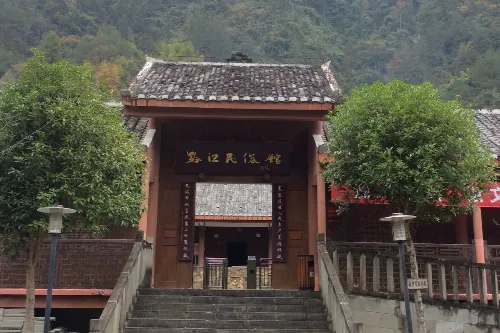

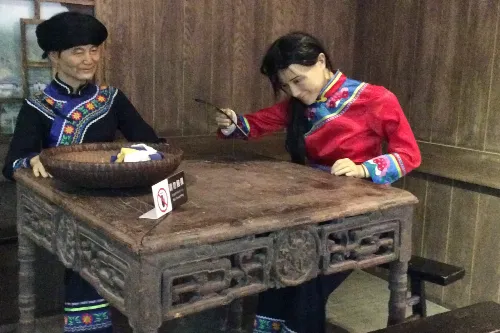
Tour Routes
In the morning, you can first climb Fengming Mountain to enjoy the panoramic view of Xiaonanhai, then take a boat tour around Xiaonanhai to visit the Xiaonanhai earthquake site, and then go ashore to explore three islands: Niubei Island, Chaoyang Temple Island, and Laoguanping Island. In the afternoon, you can visit the Qianjiang Folk Custom Museum to learn about the local Tujia culture.
Travel Tips
- It is recommended to visit in spring or autumn, as the climate is pleasant, the scenery is charming, and there are relatively fewer tourists, allowing you to better enjoy the tranquility and beauty of the area.
- You can taste local delicacies at the farm stays in the scenic area to experience Tujia flavors.
- If time permits, you can stay one night near the scenic area to enjoy the night view of Xiaonanhai and the lake and mountain scenery in the early morning.
Notes
- Xiaonanhai is located in a mountainous area with changeable weather, so it is advisable to carry rain gear and warm clothes with you.
- During the tour, please pay attention to personal safety, do not climb dangerous areas randomly, and abide by the scenic area regulations.
- Do not litter; keep the scenic area clean and tidy, and jointly protect this pure land.
- When visiting historical and cultural relics, please respect local cultural customs and do not touch or damage cultural relics at will.
- Since Xiaonanhai is in a mountainous area with strong direct sunlight, it is recommended that tourists prepare sunscreen products such as sunscreen lotion and sun hats to avoid sunburn.
- When tasting local food, pay attention to the freshness and hygiene of the food to prevent food poisoning.
- During outdoor activities, ensure that your mobile phone has sufficient battery power and download offline maps in advance for use in areas with poor signal.
Transportation
- Self-driving: Depart from Chongqing, take the Chongqing-Hunan Expressway, exit at Qianjiang, and then head to Xiaonanhai Scenic Area. The road conditions along the way are good and the roads are wide.
- Public Transportation: Take a bus from Qianjiang Bus Station to Xiaonanhai Town, and then transfer to local transportation to reach the scenic area.
Opening Hours
The scenic area is open from 8:30 to 18:00. Please refer to the actual opening hours of the scenic area.
Tickets
The ticket price starts from 60 yuan. Please refer to the actual price of the scenic area.
Online Booking
Click here to jump to the Trip.com ticketing platform for ticket purchase.


